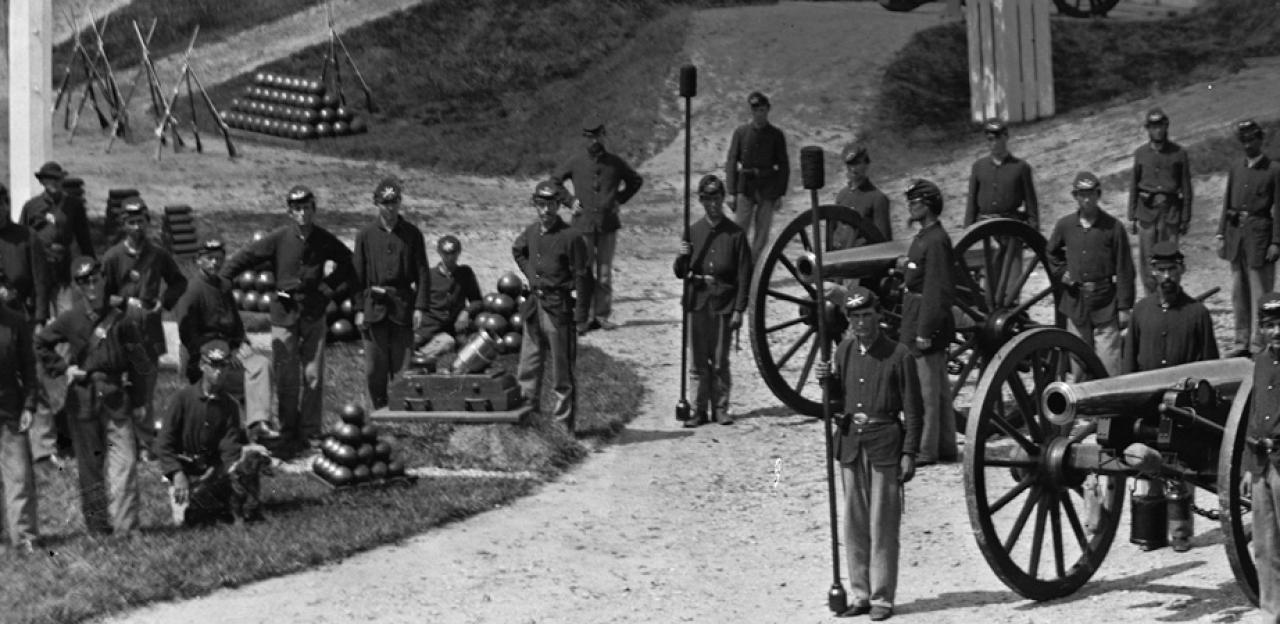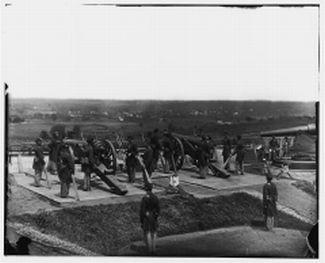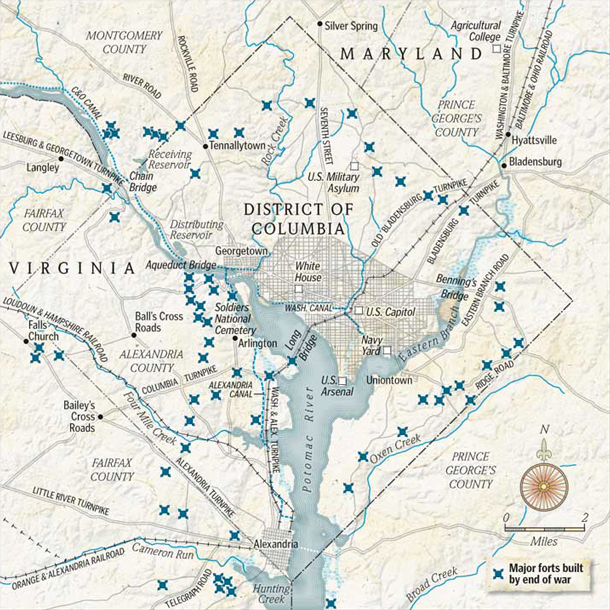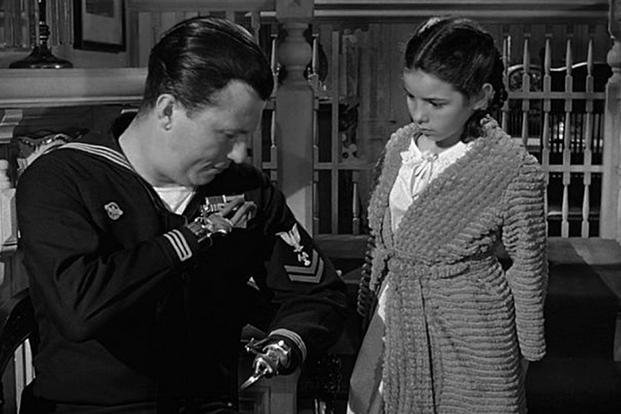American History
Related: About this forumUnion Stops Confed Attempt To Capture US Capital - Battle of Ft Stevens 1864, Lincoln Wash Defenses

- Fort Stevens in The Defenses of Washington, 'Mr. Lincoln's Forts.'
________
- 'Washington's Civil War Defenses & the Battle of Fort Stevens,' Dr. B. Franklin Cooling. - In depth.
By the close of the Civil War, Washington, D.C. was the most heavily fortified city in North America, perhaps even in the world. According to the report of the army’s official engineer, her defenses boasted 68 enclosed forts with 807 mounted cannon and 93 mortars, 93 unarmed batteries with 401 emplacements for field guns and 20 miles of rifle trenches plus three blockhouses. Moreover miles of military roads, a telegraphic communication system and supporting infrastructure- including headquarters buildings, storehouses and construction camps- ringed the city.
Thus, “the finest existing example of the system of defenses based upon a series of detached forts connected by a continuous trench line” contributed to a sense of “seeming impenetrability.” Yet, that system came close to failing at a critical juncture in the war that might well have cost President Abraham Lincoln his life, the Union its war and the country her national unification. This unsung story finds scant attention today in history books or at the various parks preserving the remains of some 22 fortifications, including Fort Stevens, site of a critical battle during Confederate Lt. Gen. Jubal Early’s 1864 attempt to capture the American capital...
https://www.battlefields.org/learn/articles/washingtons-civil-war-defenses-and-battle-fort-stevens
_____

- Fort Lincoln, Defenses of Washington, Civil War
https://en.wikipedia.org/wiki/Civil_War_Defenses_of_Washington
______

- National Park Service: Defenses of Washington- DC, MD, VA. *Visiting The Forts, Mr. Lincoln's Cottage* -
- Civil War Forts, Present-Day Parks: Forested heights and inviting parklands—a rare backdrop to most urban settings—wrap a mantle of contrast around Washington, D.C. Even more uncommon are the exceptional natural elements and remnants of history located among the hills encircling the city. High ground around Washington played a vital role in protecting the nation's capital during the Civil War. In 1860 slave states sympathetic to the Confederacy surrounded the District of Columbia, which was protected only by the brittle brick bastions of old Fort Washington, 16 miles south on the Potomac. As the prospect for war grew, tensions escalated, and Washington, D.C, lay vulnerable to attack. The Lincoln Administration realized the city urgently needed a stronger shield of defense, prompting the Federal government to seize strategic lands with views of essential roads, bridges, and waterways. As war broke out in 1861, Union forces quickly built a ring of earthen fortifications around the nation's capital and moved massive cannons into place. Hospitals and settlements sprang up nearby, providing shelter and work for many, including African American "contrabands" of war.
Most of the fortifications were dismantled or abandoned by 1866. Decades later, a plan to connect the historic sites with a scenic automobile route paved the way for their preservation. Although some elements of the Civil War Defenses of Washington eventually surrendered to time and urbanization, many fortifications and associated lands remain protected within the National Park System. Today parks and woodlands occupy the heights where heavy guns once scanned the horizon—and people stroll, hike, and bike where courageous soldiers once stood guard over the nation's capital. - "By latest accounts the enemy is moving on Washington . . . Let us be vigilant, but keep cool."- President Abraham Lincoln, Washington, D.C, July 10, 1864 -
*The Battle of Fort Stevens: By the end of 1863 heavily armed fortifications provided a perimeter of protection around the nation's capital. With 23,000 troops positioned in this ring of defenses, Washington officials felt the city was well prepared for Confederate attack. The following summer, thousands of troops stationed around Washington, D.C, were sent to reinforce General Ulysses S. Grant at Richmond and Petersburg, Virginia. Only 9,000 poorly trained reserves remained to protect the city. Confederate leaders, including General Robert E. Lee, knew the time was right to strike Washington, D.C.
By the afternoon of July 11, 1864, Confederate Lieutenant General Jubal A. Early and a force of 14,000 men had crossed the Potomac, fought at the Monocacy River near Frederick, Maryland, and encountered fire from Fort Reno, Fort DeRussy, and Fort Slocum. Early's Confederate force then assaulted Fort Stevens—only 6 miles from the U.S. Capitol. Panic spread through the city. President Lincoln urged citizens to stay calm as additional Union troops arrived. On July 12, 1864, Lincoln visited Fort Stevens to encourage the men during the conflict and barely escaped a sharpshooter's bullet. Federal troops closed in, and the fighting ended by dusk. Early retreated when he recognized the unexpected strength of the reinforced defenses of Washington... http://npshistory.com/publications/cwdw/index.htm

- President Lincoln's Cottage at The Soldiers' Home, Washington, D.C.,
https://en.wikipedia.org/wiki/President_Lincoln%27s_Cottage_at_the_Soldiers%27_Home
- Videos:
-
- NPS, Intro. The Battle of Fort Stevens; *'Find Your Fort' in the Washington, DC Area. (2 mins).
_____
- Battle of Fort Stevens, Lincoln, Blair House, Soldier Cemeteries. *Very interesting & well done video.
_____
https://www.nps.gov/media/video/view.htm%3Fid%3DB292487A-A40F-B8D8-82C22109543E9FDE
- More: Video, *On Site: The Battle of Fort Stevens, NPS Park Historian & Ranger Steve Phan. (8 mins).

- President Lincoln at Fort Stevens, depiction.
thucythucy
(8,742 posts)were members of the Invalid Corps, disabled Union soldiers who were supposed to only be stationed behind the lines, at hospitals, depots, POW camps etc. They were rushed into the line to help defend the city, and actually charged the rebels to make them think there were more defending troops than there were. This made the traitors hestitate just long enough for reinforcements sent by Grant to arrive.
It's described in a book--"The Civil War Letters of Charles F. Johnson, Invalid Corps." Colonel Johnson was the commander of an Invalid Corps regiment that also fought at White House Landing in Virginia, defending Grant's main supply depot. When a general sent the message, "Will your invalids stand?" Johnson replied, "Tell the general my men are cripples, and can't run." They too successfully fought off the rebels.
I should add, the name "Invalid Corps" was despised by its members. They pressured the army to change it to "Veterans Reserve Corps," which it was, but by and large it's still called "the Invalid Corps."
One of the great untold stories of the disability rights movement.
appalachiablue
(42,928 posts)White House Landing and in other capacities is important, thanks for adding the info. I learned a little about these troops at a Union Civil War historic site where I worked.
- Links on the US Veteran Reserve Corps in the Civil War. During the Revolutionary War, a corps of troops with disabilites was formed in the Continental Army so I read. At a White House conference on the ADA years back I enjoyed seeing WWII veteran Harold Russell the keynote speaker, Ted Kennedy, Jr. and Tony Coehlo.

- Soldiers in the US Veteran Reserve Corps.
https://en.wikipedia.org/wiki/Veteran_Reserve_Corps
- Video, PBS, The Invalid Corps
https://www.pbs.org/video/the-invalid-corps-j99gel/
- Harold Russell, Disabled WWII Veteran Wins 2 Academy Awards
https://www.military.com/off-duty/2019/12/23/disabled-wwii-veteran-was-only-actor-win-2-oscars-same-part.html

- Veteran Harold Russell as 'Homer' in the movie, 'The Best Years of Our Lives' (1946).